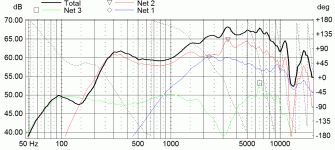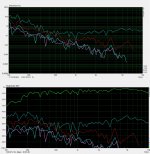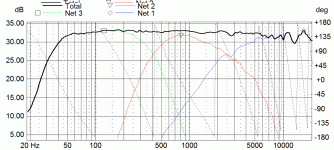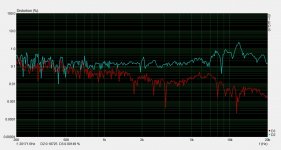Stefanoo
Seriously forget about B&W and build Nelson's slot loaded open baffle, then you won't need a beast of an Amp to drive it.
Nelson's XA30.5, F5, AlephJ, M2, J2, or his SIT mono blocks will do the job quite nicely. You might also consider the F3
You will save big dollars and most likely have a setup that sounds better than a B&W/Pass-Monster-Amp setup.
The best speaker box is no speaker box

Seriously forget about B&W and build Nelson's slot loaded open baffle, then you won't need a beast of an Amp to drive it.
Nelson's XA30.5, F5, AlephJ, M2, J2, or his SIT mono blocks will do the job quite nicely. You might also consider the F3
You will save big dollars and most likely have a setup that sounds better than a B&W/Pass-Monster-Amp setup.
The best speaker box is no speaker box

Last edited:
interesting 5th element.
Here is what I think...assuming you are right, do you think that B&W with their expert team of engineers would sell the flagship if it reall had the issue you mentioned?
It's there clear as day in the stereophile measurement of the new 800 model. I posted that image in my earlier reply to this thread.
Zaph has measured the FST and measured the same resonance, along with a corresponding peak in the distortion profile.
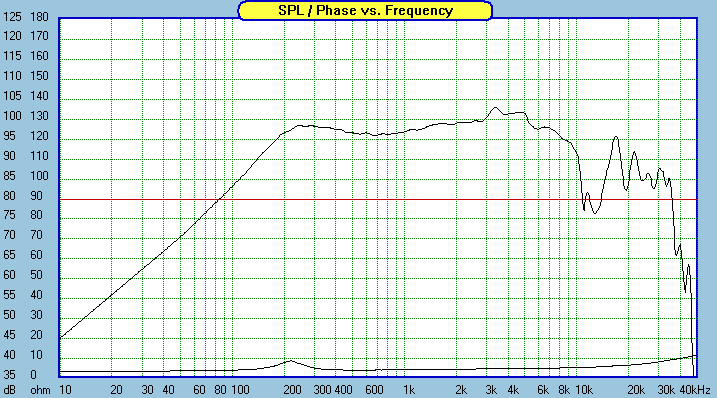
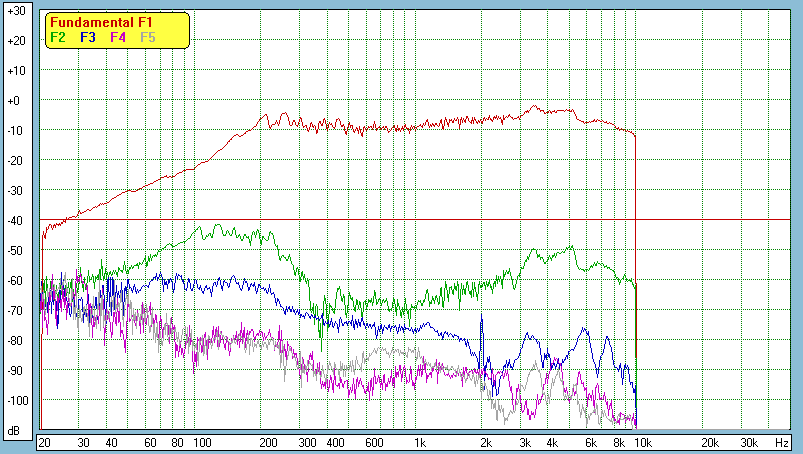
Or maybe you'd prefer my measurements. The FST here is the red trace.
And the distortion sweep.
It is this peak that gives rise to the peak in the 800, linked again for viewing ease.
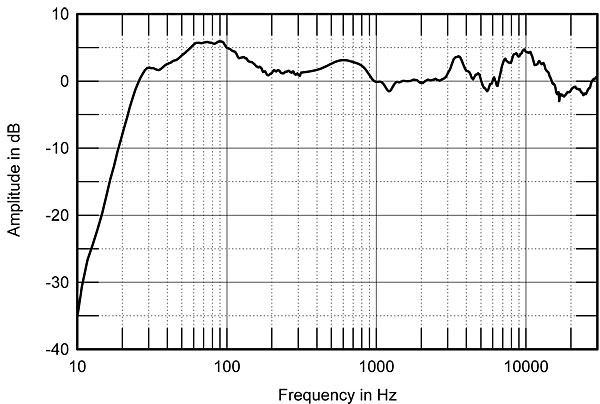
There's no two ways about this, the peak is caused by the cone of the FST going through a mild resonance that causes a peak of 4dB at around 3.5kHz. This is the region our ear is the most sensitive to and I was surprised to see that B&W hadn't filtered it out. Then again, B&W are known for using the 6.5" FST kevlar driver up high with a gentle crossover. This creates issues, but issues that also sound a specific way and will create the B&W sound. This isn't neutral, as the ragged response centred around 10k isn't neutral either, this once again being caused by the gentle filter used up very high on the FST.
Now the FST has a very well designed motor such that the distortion peak associated with this resonance is rendered a non issue - that is the peak in distortion is unlikely to be audible, but the peak in the frequency response sure will! Just listen to music on your PC and whack in a 4-5dB peak at 3.5kHz, it's very audible.
Now, do you build your speaker as your job?
Not so far, but I am unemployable due to my health.
Are you a audio/electrical engineer? Do you have concrete experience and proven experience on this filed?
I am not a qualified engineer as my health went tits up after my first year at uni where I was studying acoustics. If I ever get the chance to go back I'd probably study electrical engineering or musical composition.
As to my practical experience though, I have built several power amplifiers, analogue active crossovers, several loudspeakers - both passive and active and most recently, I've designed and built a digital input, 8 channel analogue out DSP.
Have you ever partecipated to an audio show
I have been to audio shows, yes.
Do you do any comparisons, or are you designing in a vacuum 5th ? What are you looking for , flat on axis , off or avg ..
To get any idea of sound , it takes more than just frequency response graph, impulse, phase angles, Step, impedance curves, polar plots all play a role in quality of reproduction
But you know that already ....
Yes I do know all of that already
Below is an image where I ran some distortion tests to see how hard the FST could really be pushed down low. I wont include the 2nd order tests as the driver cannot manage with a second order high-pass unless crossed very high. Here we've got a 4th order acoustic target first at 400Hz and then at 300Hz. The top graph is basically at around 95dB, the next one down at 100dB and the one below it at 105dB. You can see that the driver is having to work ever so slightly harder with the 300Hz crossover, which is as low as I'd want to take it really. Wanting to maximise what I could get out of the FST, in taking it as low as possible and then has high as would be reasonably possible to avoid the peak at 3.5kHz. The combination works very well together with a ruler flat frequency response, smooth set of off axis curves and very low distortion that is also free from any peaks.
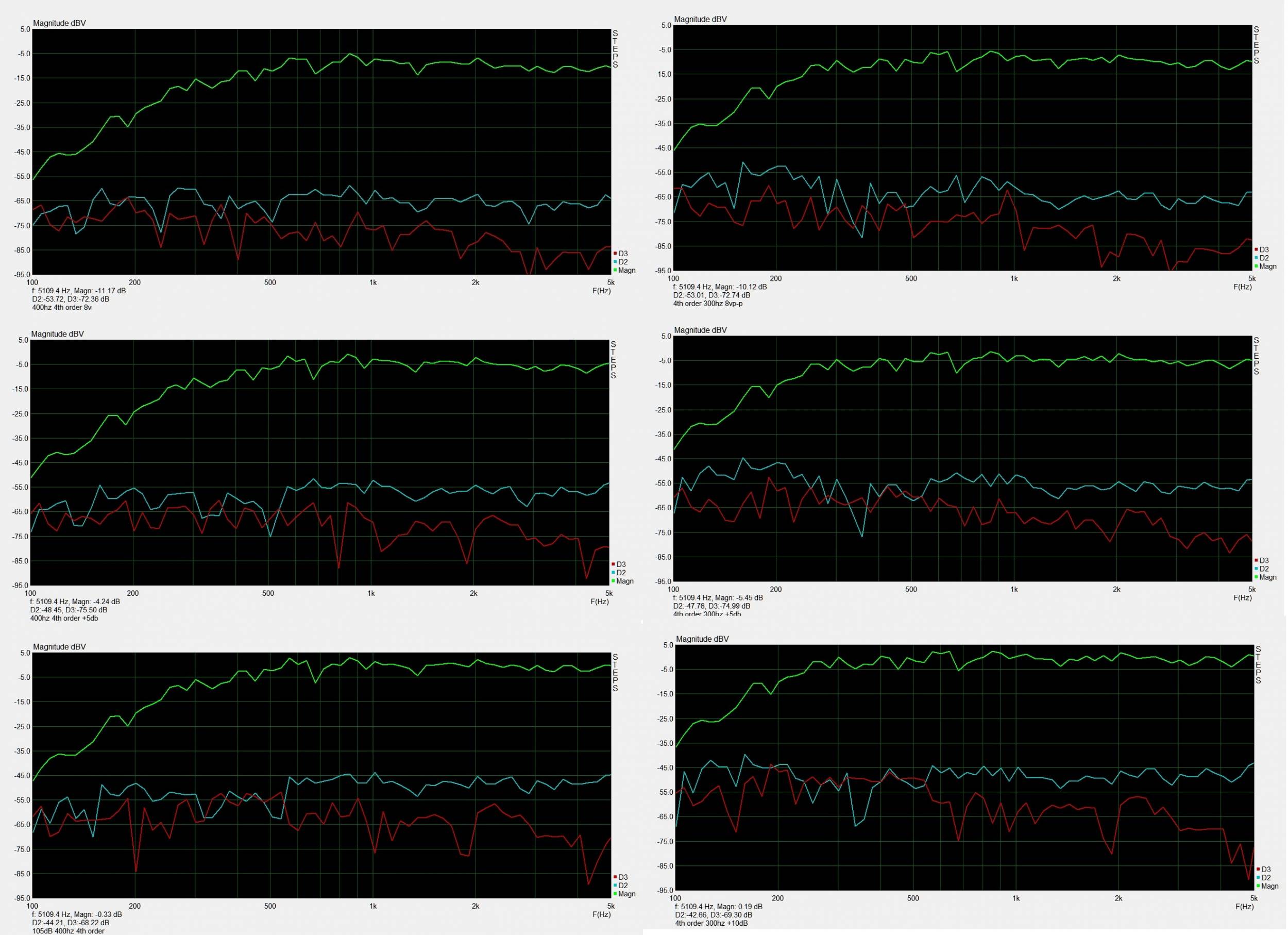
I think B&W use the FST down to around 300Hz too, which is a good idea as it's a fantastic driver, you'd certainly want to take advantage of everything it could offer, but a shallow crossover at 4kHz isn't really the best idea in my opinion. Of course B&W could have kept the xover at 4kHz and just added a load of shunt components to flatten out that peak at 3.5kHz and then smoothed the upper roll off a little more too - then we'd have a smooth on axis response, still with only one reactive series pass element. It seems odd to me that B&W would go to such lengths to reduce cabinet diffraction and then leave a hump in the response like that.
And I do have comparisons, to my own designs!
This has gone way off topic though so for that, original poster, I apologise.
Attachments
Last edited:
Stefanoo
Seriously forget about B&W and build Nelson's slot loaded open baffle, then you won't need a beast of an Amp to drive it.
Nelson's XA30.5, F5, AlephJ, M2, J2, or his SIT mono blocks will do the job quite nicely. You might also consider the F3
You will save big dollars and most likely have a setup that sounds better than a B&W/Pass-Monster-Amp setup.
The best speaker box is no speaker box

Ok I hope you are kidding!!!
Now you are assuming that the flagship B&W a $25K speaker can be replaced so easily by a diy design.
I really hope you are not serious with all due respect to NP.
To begin with the efficiency of my speaker is 92dB so they can enter the bottom end of high efficiency desings without carrying the burden and the draw backs of them.
Therefore if you wanted to, you could drive them with a low power amplifier, but I have never seen anybody doing that.
Anyhow just let me ask you few things:
1)Do you actually think that the XA30.5 sounds better than theXA100.5 or XA200.5 on a high efficiency horn or any other type of speakers just because it has less power?
2) Also do you think that the F5, F3 and whatever you mentioned actually sounds better than the latest mentioned XA200.5or than a X600.5?
The answer on both cases is simply: NO!
Simply because power matters no matter what speakers you are driving.
It's like saying that I drive a 5.5L Mercedes AMG (which is one of my cars) and then I think the other one I own the VW 1.8T drives better on roads because it's gotten less power.
It is a non-sense! You might say instead, it saves you more on gas and that is true, but not that it performs better!
3) Have you ever heard the B&W800 Signature on a proper setup in comparison with your DIY design?
4) What sound system do you have (source, preamp, power amp, speakers, cables)
I am asking that because many people evaluate things on a crappy sound system an old or cheap digital system or an analogue FE made up with a rega P3 and a denon DL103 and has a $100 cables on their system between signal speaker and power.
If you ask me, if you compare something you should first make sure you got everything, but I mean everything.
As a last disclaimer, I am not saying that you don't have a proper sound system or that you don't understand that a more powerful amp sounds better, I just want to make sure we are set on the same page.
5th,
that is a very interesting post.
Sorry for having questioned you. You are very prepared.
Also sorry to hear about your health and the health issue you had when you went to university.
Actually I had health issue at the second year as well so I had a stop for two years then I was fortunately able to overcome my problems and finish and recuperate the two years finishing almost on time.
Now I just have one thought. I am sure that B$W measures the same curve.
And if it only takes a shunt load to flatten the frequency, they know it as well.
Don't you think they would have fixed the issue you brought up?
I can tell you that I listen to them and they don't seem to have this problem IMHO. I mean talking about midrange evident problem on a flagship of a well respected speaker's manufacturer seems a bit strange to me.
Did you measure the 800D or the 800Signature?
The first uses a diamond tweeter and I don't like them as much as the N800S.
Anyhow, I can offer you my personal experience:
I am sure you know who Patricia Barber is and you probably have the album Companion.
It is recorded live at the Green Mill in Chicago.
Combination, the Green Mill is like 1 1/2 hour away from where I live and she plays there almost every Monday nigh.
So I got very confident with her voice and that room where the recordings were recorded.
I can guarantee you that there is a very, very strong resemblance with her voice, the ecos and background noises you hear on the club vs what's played through the speakers.
I heard Patricia Barber without amplification and talked to her too in several occasion and I am going this week as well .
.
I mean they get extremely, extremely close to that live performance.
If they had such a non-neutral behaviour I would have been able to tell perhaps, hard to tell.
I have listened to that recording with SEVERAL high end setups including Jamo open buffle and never had the impression of such a close resemblance with her voice I hear with the B&Ws.
In conclusion something they are doing must be right somehow..and again...measurements on speakers are very important...but like on amplifier they matter till a certain degree.
These are my two cents take them as is and thank you very much for your technical contribute.
that is a very interesting post.
Sorry for having questioned you. You are very prepared.
Also sorry to hear about your health and the health issue you had when you went to university.
Actually I had health issue at the second year as well so I had a stop for two years then I was fortunately able to overcome my problems and finish and recuperate the two years finishing almost on time.
Now I just have one thought. I am sure that B$W measures the same curve.
And if it only takes a shunt load to flatten the frequency, they know it as well.
Don't you think they would have fixed the issue you brought up?
I can tell you that I listen to them and they don't seem to have this problem IMHO. I mean talking about midrange evident problem on a flagship of a well respected speaker's manufacturer seems a bit strange to me.
Did you measure the 800D or the 800Signature?
The first uses a diamond tweeter and I don't like them as much as the N800S.
Anyhow, I can offer you my personal experience:
I am sure you know who Patricia Barber is and you probably have the album Companion.
It is recorded live at the Green Mill in Chicago.
Combination, the Green Mill is like 1 1/2 hour away from where I live and she plays there almost every Monday nigh.
So I got very confident with her voice and that room where the recordings were recorded.
I can guarantee you that there is a very, very strong resemblance with her voice, the ecos and background noises you hear on the club vs what's played through the speakers.
I heard Patricia Barber without amplification and talked to her too in several occasion and I am going this week as well
I mean they get extremely, extremely close to that live performance.
If they had such a non-neutral behaviour I would have been able to tell perhaps, hard to tell.
I have listened to that recording with SEVERAL high end setups including Jamo open buffle and never had the impression of such a close resemblance with her voice I hear with the B&Ws.
In conclusion something they are doing must be right somehow..and again...measurements on speakers are very important...but like on amplifier they matter till a certain degree.
These are my two cents take them as is and thank you very much for your technical contribute.
Stefanoo.
I am not saying the flagship B&W speaker is a bad speaker design, but since you mentioned budget concerns I am offering very honest advice.
I have not heard the top of the range B&W but a mid-pricec B&W I did hear was easily beaten by Krix Neuphonix and my open baffle easily beats the Krix. When you build open baffle there are so many issues you no longer need to deal with, hence a massive reduction in R&D resources, as well as a reduction in building materials.
Appologies for not properly checking out the specs of the B&W I was under the impression they were around 87dB.
Regarding amps, I have found +/-10V in excess of your requirements tends to be about the sweetspot then bias the hell out of it.
I think you would bery surprised if you built NPs open baffle with lowther pm6a and 6x10" or 8". My comments are based on bang per buck, so if you can happily pay for all that gear then I envy you, but you can do a lot with around $3000 in diy dollars if you are willing to try.
I am not saying the flagship B&W speaker is a bad speaker design, but since you mentioned budget concerns I am offering very honest advice.
I have not heard the top of the range B&W but a mid-pricec B&W I did hear was easily beaten by Krix Neuphonix and my open baffle easily beats the Krix. When you build open baffle there are so many issues you no longer need to deal with, hence a massive reduction in R&D resources, as well as a reduction in building materials.
Appologies for not properly checking out the specs of the B&W I was under the impression they were around 87dB.
Regarding amps, I have found +/-10V in excess of your requirements tends to be about the sweetspot then bias the hell out of it.
I think you would bery surprised if you built NPs open baffle with lowther pm6a and 6x10" or 8". My comments are based on bang per buck, so if you can happily pay for all that gear then I envy you, but you can do a lot with around $3000 in diy dollars if you are willing to try.
There's no point in arguing subjective impressions, there's a lot that the 800D does well and that peak would be more audible if the roughness around 10k wasn't there. However the peak is there, plain as day, in the stereophile measurement and both Zaph and my own measurements. Notching it out is the logical thing to do, unless you aspire to the less is more approach to crossover design, something that B&W obviously do. Leaving the peak in will colour the sound, there's not a lot more that can be said on the issue, if you like the way that sounds then good for you. I never said the peak would make the loudspeakers sound bad, just that they wouldn't be neutral because of it.
Stefanoo
Seriously forget about B&W and build Nelson's slot loaded open baffle, then you won't need a beast of an Amp to drive it.
Nelson's XA30.5, F5, AlephJ, M2, J2, or his SIT mono blocks will do the job quite nicely. You might also consider the F3
You will save big dollars and most likely have a setup that sounds better than a B&W/Pass-Monster-Amp setup.
The best speaker box is no speaker box

yep .. except for bass ....
It's there clear as day in the stereophile measurement of the new 800 model. I posted that image in my earlier reply to this thread.
And the distortion sweep.
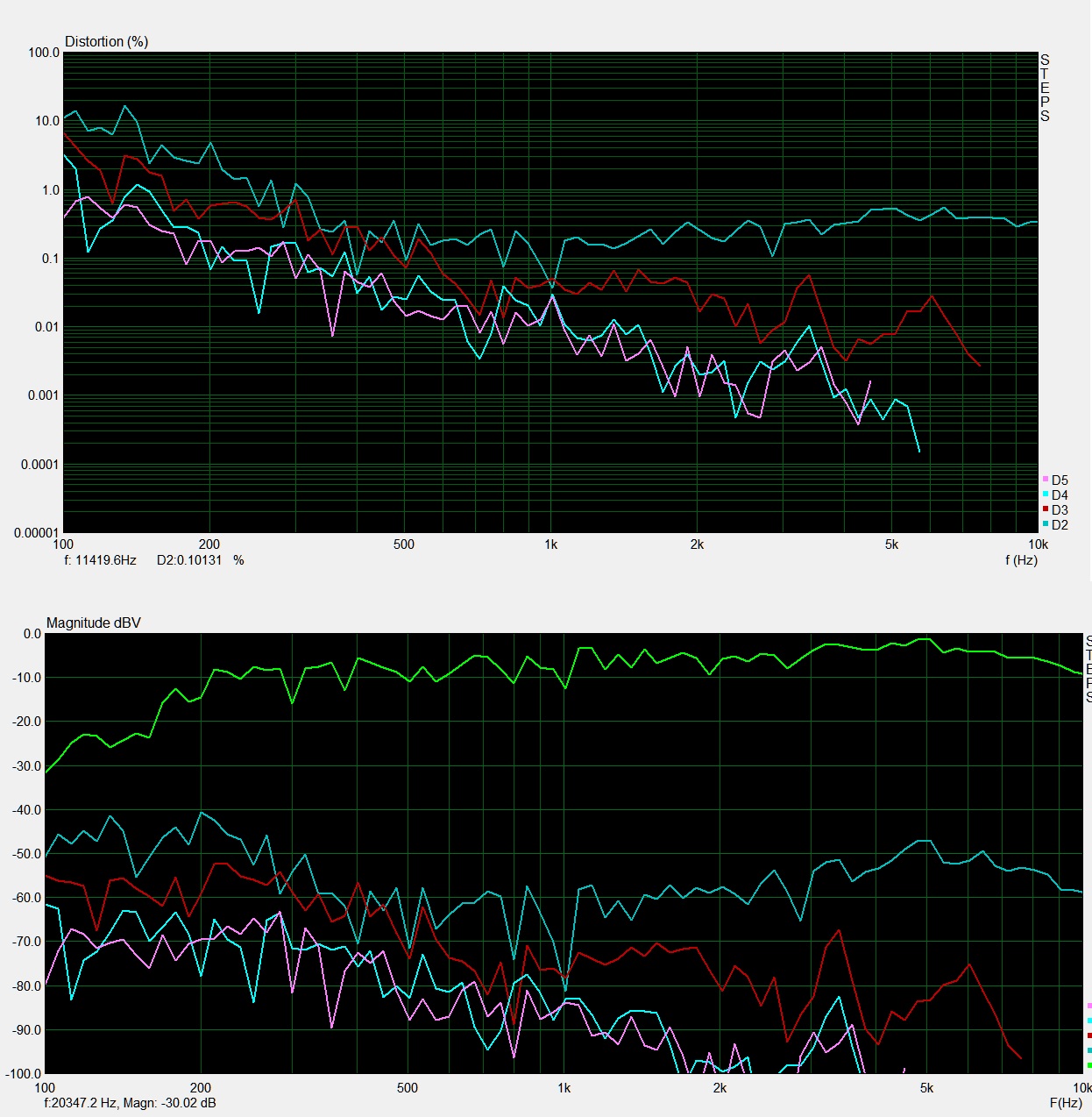
It is this peak that gives rise to the peak in the 800, linked again for viewing ease.

There's no two ways about this, the peak is caused by the cone of the FST going through a mild resonance that causes a peak of 4dB at around 3.5kHz. This is the region our ear is the most sensitive to and I was surprised to see that B&W hadn't filtered it out. Then again, B&W are known for using the 6.5" FST kevlar driver up high with a gentle crossover. This creates issues, but issues that also sound a specific way and will create the B&W sound. This isn't neutral, as the ragged response centred around 10k isn't neutral either, this once again being caused by the gentle filter used up very high on the FST.
Now the FST has a very well designed motor such that the distortion peak associated with this resonance is rendered a non issue - that is the peak in distortion is unlikely to be audible, but the peak in the frequency response sure will! Just listen to music on your PC and whack in a 4-5dB peak at 3.5kHz, it's very audible.
Not so far, but I am unemployable due to my health.
I am not a qualified engineer as my health went tits up after my first year at uni where I was studying acoustics. If I ever get the chance to go back I'd probably study electrical engineering or musical composition.
As to my practical experience though, I have built several power amplifiers, analogue active crossovers, several loudspeakers - both passive and active and most recently, I've designed and built a digital input, 8 channel analogue out DSP.
I have been to audio shows, yes.
Yes I do know all of that alreadyThe FST design uses a 6" wave-guide along with the HDS tweeter made by scan speak, this allows me to crossover at 2.5kHz with a 2nd order acoustic whilst maintaining a very smooth set of off axis curves. The DSP time aligns the whole thing and as it's active each amplifier sees a rather benign load. Not to mention the mid-band sensitivity is pretty high, the FST being 95dB+, with the HDS tweeter hitting around 96dB too at the point where the wave-guide is doing the most. It goes loud very easily.
Below is an image where I ran some distortion tests to see how hard the FST could really be pushed down low. I wont include the 2nd order tests as the driver cannot manage with a second order high-pass unless crossed very high. Here we've got a 4th order acoustic target first at 400Hz and then at 300Hz. The top graph is basically at around 95dB, the next one down at 100dB and the one below it at 105dB. You can see that the driver is having to work ever so slightly harder with the 300Hz crossover, which is as low as I'd want to take it really. Wanting to maximise what I could get out of the FST, in taking it as low as possible and then has high as would be reasonably possible to avoid the peak at 3.5kHz. The combination works very well together with a ruler flat frequency response, smooth set of off axis curves and very low distortion that is also free from any peaks.

I think B&W use the FST down to around 300Hz too, which is a good idea as it's a fantastic driver, you'd certainly want to take advantage of everything it could offer, but a shallow crossover at 4kHz isn't really the best idea in my opinion. Of course B&W could have kept the xover at 4kHz and just added a load of shunt components to flatten out that peak at 3.5kHz and then smoothed the upper roll off a little more too - then we'd have a smooth on axis response, still with only one reactive series pass element. It seems odd to me that B&W would go to such lengths to reduce cabinet diffraction and then leave a hump in the response like that.
And I do have comparisons, to my own designs!But before I went DIY, to commercial offerings also, but once I realised I could build better for less, I haven't bothered with anything else. Besides doing it yourself is so much more fun
This has gone way off topic though so for that, original poster, I apologise.
5th,
your are using 10 db deviation scale , pretty bumpy ride for 10 db scale. What software are you using to generate the distortion numbers..
I'm interested in seeing impulse and step response , xover points and type is very important in sizing, realism of image size is very important in sounding real ...
Anyway way off topic here i guess .....
If you strain the brain just a fraction (a little bit more than while asleep), then bass is easily taken care of.yep .. except for bass
I have not heard the top of the range B&W but a mid-pricec B&W ............................................................................
I think you would bery surprised if you built NPs open baffle with lowther pm6a
Afraid i am with Stephanoo here. The mid range B&W are imho quite bad to put it politely. The 800 and 801, N or D are entirely different and i could easily live with either. Anything based on the Lowther PM6A otoh is indescribably bad to my ears. And it's not just the bass, far from it. If one likes the flagship B&W it's ridiculous to also like a Lowther type of aural misunderstanding.
I am sure there must be other people that actually heard Nelson's speaker that might be able to comment whether they experienced "aural misunderstanding" .
Considering Nelson has the means to own any loudspeaker he wants, and has probably heard 90% of all loudspeakers worth hearing.
I am really struggling to accept that the lowther PM6A could be that bad, given the fact it seems Nelson actually prefers to listen to these in his home.
Considering Nelson has the means to own any loudspeaker he wants, and has probably heard 90% of all loudspeakers worth hearing.
I am really struggling to accept that the lowther PM6A could be that bad, given the fact it seems Nelson actually prefers to listen to these in his home.
Last edited:
I have heard the B&W 802 and while they are good, they do not wow me enough to ever consider spending that kind of money. Fact is, at some point, music and musical preference becomes very personal, and to quantify quality is like performing certain acts in the wind. I agree with Melon in so much as I think you can get VERY good sound out of DIY speakers that perhaps rivals top makers. Some of the most highly aclaimed speakers use the same ol drivers all of us can get. ZM is right that there is very little that is "new" under the sun, including B&W technology, but if we recognize this, then we have nothing to chatter about after buying 20k speakers. I recently listened to a fully active, top of the line, Linn system coming in at about 100,000k. It sounded great. Whoopty Doo. It cost 100k. I bet ZM or MH could probably come real close with about 5K or less. Just speculating though and I know this thread is no place for that

Fact is, at some point, music and musical preference becomes very personal, and to quantify quality is like performing certain acts in the wind.
Would those acts be with your pants, on or off?

Could you explain what you mean by aural misunderstanding. That does not tell me much.
Well, it wouldn't. You need to spend years married to a pair of Lowthers to appreciate their true awfulness
To put it simply, these types of transducers allow for a very intimate and direct connection to a certain type of music. All other types result in feelings ranging between mild headaches and skull splitting migraines. The idea that a tweezer cone can replace a proper tweeter is just wrong.
The nicer B&Ws otoh may sound veiled in comparison and yes, there is a pronounced lift at certain frequencies. Still, they hold remarkably well at any power level, both tonally and in respect of sound staging and subjective distortion. And they play well a wide range of music.
yep .. except for bass ....
5th,
your are using 10 db deviation scale , pretty bumpy ride for 10 db scale. What software are you using to generate the distortion numbers..
I'm interested in seeing impulse and step response , xover points and type is very important in sizing, realism of image size is very important in sounding real ...
Anyway way off topic here i guess .....
The ride is always bumpy when looking at STEPS' stepped sine distortion sweeps, the reason for this is that the mic is a reasonable distance away from the loudspeakers, without any gate, so room reflections come in. This doesn't really affect the distortion much as per say, but does affect the flatness of the frequency response. Also STEPS (part of ARTA) does the tests at stepped frequencies, ie, it's not continuous, so you pick how many different frequencies per octave it tests at. The more you pick, the longer it takes, those were done at 12/octave.
You call that bumpy, 10dB/div is normal for distortion sweeps, but even with the less then stellar way of measuring the frequency response it's still within +-2dB for the most part. With a proper gated measurement the loudspeakers are more like +-0.5dB apart from a little squiggle at high frequencies due to the wave-guide.
Here's a stepped sine sweep at 48 steps/octave, this is done at what I consider the loudest I tend to listen at. The 4th, 5th and 6th+ harmonics are not shown as they are much lower in level. The sweep stops at 200Hz because below that the accuracy dies tremendously due to the room reflections.
I have already said, that I use 2nd order slopes on the mid/tweeter and 4th order slopes on the bass/mid. These are both of the linkwitz variety and as mentioned before, have been time aligned with the DSP so that both exhibit strong nulls with the polarity reversed at the listening position. Nevertheless here's the simulated frequency response in LspCAD.
And I can assure you that the real life measurements match up very closely, the fine tuning on the time alignment was done in real life mind you by altering the delay until the largest nulls were reached at the listening position.
The impulse and step responses are fairly useless pieces of information imo, but needless to say both hand over smoothly from driver to driver, with a little bit of ringing evident in the impulse response from to the kink in the top octave due to the wave-guide.
Attachments
- Status
- This old topic is closed. If you want to reopen this topic, contact a moderator using the "Report Post" button.
- Home
- Amplifiers
- Pass Labs
- output devices on X -X.5 and XA.5
